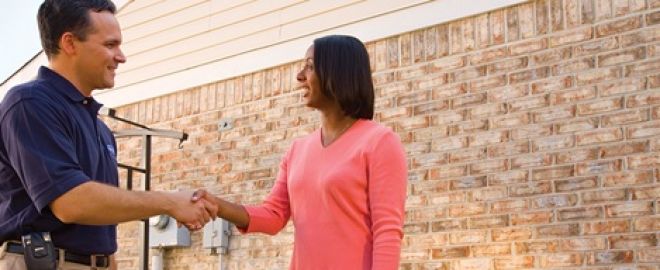Most people replace their car more frequently than their HVAC system. By the time you’re ready to trade your old heating or cooling system for something new, it may have been years since you had an HVAC consultation.

So, what should you expect when you call to set up a free sales consultation? What kind of information should you seek? That’s what we’re here to answer.
There’s no way around it: An HVAC (heating, ventilation, air conditioning) system is a big purchase.
When you start meeting with HVAC contractors, you should set your expectations high. Really high.
In particular, here are 7 things you should expect – and require – from every contractor trying to earn your business.
1. Explanation of the pre-installation process

Some HVAC contractors will say things like this: “Oh, we just come over and take out the old system. Then we’ll put in a new system that’s the same size. Don’t worry. We’ll let you keep your ductwork.”
If you hear this story or some version of it, thank the contractor for their time and hire somebody else.
This is the old “rules of thumb” approach to heating and air conditioning. It fails to consider unique attributes of your home that can have a profound impact on HVAC system selection. Not only that, it ignores your specific objectives for keeping your home comfortable.
To be worthy of your business, an HVAC contractor needs to follow a rigorous pre-installation process that they’re happy to explain to you during an initial consultation.
Furthermore, that process must – and this is not optional! – include an exercise called a Manual J load calculation. To complete a load calculation, the contractor takes several measurements throughout your home in an effort to determine the proper sizes for your heating and air conditioning systems.
An HVAC contractor who can’t or won’t perform a load calculation before recommending a new system isn’t the HVAC contractor for you.
Without a load calculation, you could end up with an oversized or undersized HVAC system that you regret ever buying. It actually happens a lot. Even if you are only looking to replace an HVAC system’s indoor OR outdoor unit and keeping the other half, a load calculation must still be done to a – ensure the system actually is the right size for the home and b – that the new unit is compatible with the one staying.

The pre-installation process should also include a ductwork analysis to see whether your existing ductwork is capable of delivering the right amount of conditioned air to all areas of your home. If it isn’t, you might need to modify your ducts to ensure the new system works the way it’s designed to. Providing a ductwork diagram is a key step in the consultation process.
2. Lots of questions
A consultation should be consultative. The consultant’s goal should be to help you get the most comfortable, efficient HVAC solution that’s within your budget. To do that, they need to ask a lot of questions. Expect to hear questions about:
- General comfort during different times of year
- Problem areas of the home that are less comfortable than others
- Hot spots and cold spots during summer and winter, respectively
- Humidity issues, whether high in the summer or low in the winter
- Noise levels from the HVAC system and ductwork
- Your satisfaction with indoor air quality
Questions like these help the consultant diagnose problems you may be having with the current system and develop an idea of what kind of replacement might work best. If a consultant fails to ask about these things, they’re flying blind.

3. A design-minded approach
Can your contractor handle a challenge? Not all HVAC installations are super straightforward. If you’re trying to solve a number of problems (like those things the contractor should have asked you about in #2 above), a contractor better have the expertise to design an HVAC system that works for your home.
A contractor who understands HVAC design is far more likely to install a system that meets your comfort goals.
4. Overview of code deficiencies
Building codes change often, and your home doesn’t have to be old to be code-deficient in some way or another.
Your consultant should perform a visual analysis of your current HVAC system, including an inspection of ancillary components. Think gas line fittings, the vent pipe, electrical connections, and so forth.
Afterward, he or she should be able to tell you what isn’t up to code right now but will be brought up to code following the new installation.
To be clear, this is a basic overview based on visual inspection. Additional code deficiencies may be revealed during the pre-installation or installation process.
5. Ductwork overview
During an initial HVAC consultation, there’s no way to know the specific sizes or lengths of ductwork you need. However, your consultant can and should inspect your ductwork to get a sense of anything that may need to be fixed, resized, etc.

This analysis helps the consultant understand how your ducts may be contributing to comfort problems or making your current system operate less efficiently than it should. While you should expect a more rigorous analysis during the pre-installation process, an HVAC consultant can get a basic sense of your ductwork situation by visual inspection alone.
6. Basic technical overview
Upon further inspection, your consultant should check whether your current system meets basic operational requirements. Examples include:
- Refrigerant line set size
- Clearance of the outdoor unit
- Drainage design for an air conditioning system
A simple visual analysis (and possibly a few measurements) will show the consultant whether your current HVAC setup requires some adjustments. This is something you’ll want to know whether or not you ultimately purchase a new system from the contractor!
7. Variety of budget-friendly system types and efficiencies
When the contractor presents you with replacement options for your current system, he or she should be able to show you:
- Different system types (single-speed, two-speed, variable speed)
- Different system efficiencies (SEER ratings and AFUE percentages)
- Different price ranges for new equipment
- Different financing options and/or rebate offers
There’s a lot of choice in HVAC today, so you shouldn’t expect a contractor to limit you to one or two different types of systems. The options presented should be tied to the analysis the consultant performed. In other words, the consultant should be showing you equipment options (and possibly ancillary HVAC services) that will help you solve your unique comfort problems.

That’s a lot to expect from an HVAC consultation. But it’s exactly what you should expect.
When a consultant fails to deliver on any of the above expectations, keep looking. You’ll eventually find an HVAC contractor who cares about providing the right equipment and services for your home.
At Total Mechanical Systems, we take pride in always providing this level of rigor and attention during our free HVAC consultations at homes throughout Connecticut.
Our consultants check every box listed above. We don’t do things this way because it’s cheap or easy. (It’s neither). We do it because we want our clients to be comfortable, we want their systems to last as long as possible, and we want to do work we can be proud of.
The way we see it, you should expect nothing less.
View our current offers HERE.


